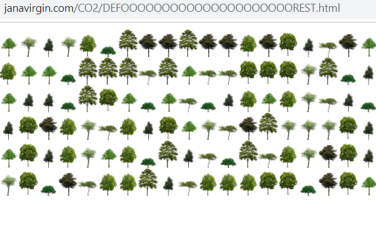
"DEFOOOOOOOOOOOOOOOOOOOOOREST" by Joana Moll.
It is an internet-based piece that shows the number of trees needed to absorb the amount of CO2 generated by global visits to google.com every second.
The project has been created with the aim of exploring strategies that will trigger thoughts and actions capable of highlighting the invisible connections between actions and consequences when using digital communication technology.
Despite being intensely involved in the logic of networks, the network society has not succeeded in transposing it in everyday life. We lazily assume that "everything is connected", but in fact we must remember that, as Graham Harman said, "everything is not connected". While humans are becoming increasingly machine-like and data dependent, the connection between humans and their lives in contact with natural habitats is rapidly disappearing. It seems that we have withdrawn into a mechanical vacuum of reality that blinds us to the complexities of the world. It is therefore necessary to continually trace the connections between things in order to acquire a complex understanding of the world.
Google.com is the most visited website on the Internet. The website has an average of 52,000 visits per second* and weighs around 2 MB, resulting in an estimated 500 kg of CO2 emissions per second**. On average, a tree can absorb 21.77 kg of CO2 per year***. Therefore, to offset the amount of CO2 emissions from global visits to google.com, each second we would need approximately 23 trees.
The actual configuration of technology reinforces cultural dynamics (rituals) that emphasise disconnection. In our contemporary algorithmic decision-making society, ecosystems are increasingly seen as mere economic externalities. How can we recreate our relationship with the world if we cannot see the real impact of our actions in the concrete world? What could be the role of media art in reinforcing this process? What fundamental changes must occur in the sphere of art to reveal the connections between actions and consequences, especially when those actions are mediated by technology? I think it is crucial to establish the environment as a principal actor within the artistic discourse of the network society and to create mechanisms that stimulate and reappropriate subjectivity.
Special thanks to Ramin Soleymani
[On average, this project emits 0.04 g of CO2 per visit]
Video: Presentation of the artwork with Joana Moll and Jaime de los Ríos (ES)
It is an internet-based piece that shows the number of trees needed to absorb the amount of CO2 generated by global visits to google.com every second.
